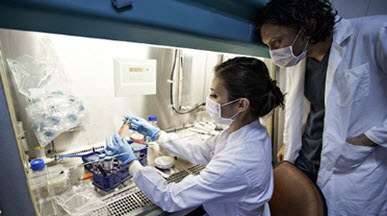Home
- Nanopinion: The advent of XBenes - a new class of quasi two-dimensional nanomaterials, bringing forth a new paradigm in energy materials
- 16 July 2024
Read the latest Nanopinion by Prof. Kabeer Jasuja and Satadru Chakrabarty where they introduce XBenes, a class of quasi two-dimensional nanomaterials, set to transform energy material research.
-
25 June 2024
Nanopinion: NAM-based hazard assessment of nanocellulose - intestinal uptake, colonic fate and local effects of ingested nanocellulose
The European Food Safety Authority (EFSA) has highlighted potential health risks associated with ingesting nanocellulose (NC); a material increasingly used in the food industry. The research, led by Francesco Cubadda, Maria Chiara Astuto and Olimpia Vincentini, uses advanced New Approach Methodologies (NAMs) to evaluate NC's intestinal uptake, local effects, and colonic fate.
-
18 June 2024
ECHA calls for research on nanomaterials
The European Chemicals Agency (ECHA) invites the scientific community to expand the knowledge on nanomaterials. ECHA's report "Key Areas of Regulatory Challenge" (KARC) underscores gaps in chemical data regarding nano-sized materials.
-
13 June 2024
Evaluation of the EUON: Answer our survey
The European Chemicals Agency (ECHA) is conducting an evaluation on the functioning of the European Union Observatory for Nanomaterials (EUON).
We invite you to participate in this short survey. Your opinion matters to us!
Nanomaterials and health
 Nanomaterials and health
Nanomaterials and health
Are substances in nanoforms more dangerous than they are in their normal size? Some are and some are not. Just like any other chemical substance, nanomaterials have to be assessed separately.
 Fighting cancer using nanotechnology
Fighting cancer using nanotechnology
Nanomaterials are not only used in consumer products, but also in new and innovative medical treatments. Research has shown that nanoparticles can be used to damage and even destroy cancer cells from within.
More on the web
Ultra-low threshold lasing in organic polymer blend microspheres with the highest Q factor
22 JUL | Source: IMDEA Nanociencia
WashU researchers shine light on amyloid architecture
19 JUL | Source: Washington University in St. Louis
New Technique to Diagnose Cancer Metastasis Uses Origami Nanoprobes
18 JUL | Source: Johns Hopkins University
New technique pinpoints nanoscale ‘hot spots’ in electronics to improve their longevity
17 JUL | Source: University of Rochester
Enzyme-powered ‘snot bots’ help deliver drugs in sticky situations
17 JUL | Source: American Chemical Society





 ,
,